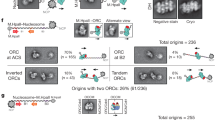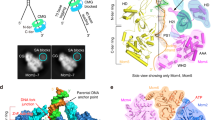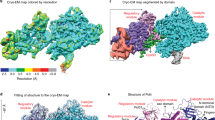Abstract
In eukaryotes, the Cdt1-bound replicative helicase core MCM2-7 is loaded onto DNA by the ORC–Cdc6 ATPase to form a prereplicative complex (pre-RC) with an MCM2-7 double hexamer encircling DNA. Using purified components in the presence of ATP-γS, we have captured in vitro an intermediate in pre-RC assembly that contains a complex between the ORC–Cdc6 and Cdt1–MCM2-7 heteroheptamers called the OCCM. Cryo-EM studies of this 14-subunit complex reveal that the two separate heptameric complexes are engaged extensively, with the ORC–Cdc6 N-terminal AAA+ domains latching onto the C-terminal AAA+ motor domains of the MCM2-7 hexamer. The conformation of ORC–Cdc6 undergoes a concerted change into a right-handed spiral with helical symmetry that is identical to that of the DNA double helix. The resulting ORC–Cdc6 helicase loader shows a notable structural similarity to the replication factor C clamp loader, suggesting a conserved mechanism of action.
This is a preview of subscription content, access via your institution
Access options
Subscribe to this journal
Receive 12 print issues and online access
$189.00 per year
only $15.75 per issue
Buy this article
- Purchase on Springer Link
- Instant access to full article PDF
Prices may be subject to local taxes which are calculated during checkout







Similar content being viewed by others
References
Bell, S.P. & Dutta, A. DNA replication in eukaryotic cells. Annu. Rev. Biochem. 71, 333–374 (2002).
Stillman, B. Origin recognition and the chromosome cycle. FEBS Lett. 579, 877–884 (2005).
Bell, S.P. & Stillman, B. ATP-dependent recognition of eukaryotic origins of DNA replication by a multiprotein complex. Nature 357, 128–134 (1992).
Remus, D. & Diffley, J.F. Eukaryotic DNA replication control: lock and load, then fire. Curr. Opin. Cell Biol. 21, 771–777 (2009).
Speck, C., Chen, Z., Li, H. & Stillman, B. ATPase-dependent cooperative binding of ORC and Cdc6 to origin DNA. Nat. Struct. Mol. Biol. 12, 965–971 (2005).
Clarey, M.G. et al. Nucleotide-dependent conformational changes in the DnaA-like core of the origin recognition complex. Nat. Struct. Mol. Biol. 13, 684–690 (2006).
Li, H. & Stillman, B. The origin recognition complex: a biochemical and structural view. Subcell. Biochem. 62, 37–58 (2012).
Santocanale, C. & Diffley, J.F. ORC- and Cdc6-dependent complexes at active and inactive chromosomal replication origins in Saccharomyces cerevisiae. EMBO J. 15, 6671–6679 (1996).
Donovan, S., Harwood, J., Drury, L.S. & Diffley, J.F. Cdc6p-dependent loading of Mcm proteins onto pre-replicative chromatin in budding yeast. Proc. Natl. Acad. Sci. USA 94, 5611–5616 (1997).
Randell, J.C., Bowers, J.L., Rodriguez, H.K. & Bell, S.P. Sequential ATP hydrolysis by Cdc6 and ORC directs loading of the MCM2-7 helicase. Mol. Cell 21, 29–39 (2006).
Sun, J. et al. Cdc6-induced conformational changes in ORC bound to origin DNA revealed by cryo-electron microscopy. Structure 20, 534–544 (2012).
Evrin, C. et al. A double-hexameric MCM2-7 complex is loaded onto origin DNA during licensing of eukaryotic DNA replication. Proc. Natl. Acad. Sci. USA 106, 20240–20245 (2009).
Remus, D. et al. Concerted loading of MCM2-7 double hexamers around DNA during DNA replication origin licensing. Cell 139, 719–730 (2009).
Moyer, S.E., Lewis, P.W. & Botchan, M.R. Isolation of the Cdc45/MCM2-7/GINS (CMG) complex, a candidate for the eukaryotic DNA replication fork helicase. Proc. Natl. Acad. Sci. USA 103, 10236–10241 (2006).
Ilves, I., Petojevic, T., Pesavento, J.J. & Botchan, M.R. Activation of the MCM2-7 helicase by association with Cdc45 and GINS proteins. Mol. Cell 37, 247–258 (2010).
Kang, Y.H., Galal, W.C., Farina, A., Tappin, I. & Hurwitz, J. Properties of the human Cdc45/MCM2-7/GINS helicase complex and its action with DNA polymerase epsilon in rolling circle DNA synthesis. Proc. Natl. Acad. Sci. USA 109, 6042–6047 (2012).
Heller, R.C. et al. Eukaryotic origin-dependent DNA replication in vitro reveals sequential action of DDK and S-CDK kinases. Cell 146, 80–91 (2011).
Costa, A. et al. The structural basis for MCM2-7 helicase activation by GINS and Cdc45. Nat. Struct. Mol. Biol. 18, 471–477 (2011).
Gaudier, M., Schuwirth, B.S., Westcott, S.L. & Wigley, D.B. Structural basis of DNA replication origin recognition by an ORC protein. Science 317, 1213–1216 (2007).
Dueber, E.L., Corn, J.E., Bell, S.D. & Berger, J.M. Replication origin recognition and deformation by a heterodimeric archaeal Orc1 complex. Science 317, 1210–1213 (2007).
Clarey, M.G., Botchan, M. & Nogales, E. Single particle EM studies of the Drosophila melanogaster origin recognition complex and evidence for DNA wrapping. J. Struct. Biol. 164, 241–249 (2008).
Liu, C. et al. Structural insights into the Cdt1-mediated MCM2-7 chromatin loading. Nucleic Acids Res. 40, 3208–3217 (2012).
Lyubimov, A.Y., Costa, A., Bleichert, F., Botchan, M.R. & Berger, J.M. ATP-dependent conformational dynamics underlie the functional asymmetry of the replicative helicase from a minimalist eukaryote. Proc. Natl. Acad. Sci. USA 109, 11999–12004 (2012).
Onesti, S. & MacNeill, S.A. Structure and evolutionary origins of the CMG complex. Chromosoma 122, 47–53 (2013).
Forsburg, S.L. Eukaryotic MCM proteins: beyond replication initiation. Microbiol. Mol. Biol. Rev. 68, 109–131 (2004).
Bochman, M.L. & Schwacha, A. The Mcm complex: unwinding the mechanism of a replicative helicase. Microbiol. Mol. Biol. Rev. 73, 652–683 (2009).
Brewster, A.S. et al. Crystal structure of a near-full-length archaeal MCM: functional insights for an AAA+ hexameric helicase. Proc. Natl. Acad. Sci. USA 105, 20191–20196 (2008).
Chesnokov, I.N., Chesnokova, O.N. & Botchan, M. A cytokinetic function of Drosophila ORC6 protein resides in a domain distinct from its replication activity. Proc. Natl. Acad. Sci. USA 100, 9150–9155 (2003).
Khayrutdinov, B.I. et al. Structure of the Cdt1 C-terminal domain: conservation of the winged helix fold in replication licensing factors. Protein Sci. 18, 2252–2264 (2009).
Bowers, J.L., Randell, J.C., Chen, S. & Bell, S.P. ATP hydrolysis by ORC catalyzes reiterative MCM2-7 assembly at a defined origin of replication. Mol. Cell 16, 967–978 (2004).
Pape, T. et al. Hexameric ring structure of the full-length archaeal MCM protein complex. EMBO Rep. 4, 1079–1083 (2003).
Suck, D. & Oefner, C. Structure of DNase I at 2.0-Å resolution suggests a mechanism for binding to and cutting DNA. Nature 321, 620–625 (1986).
Henderson, R. et al. Tilt-pair analysis of images from a range of different specimens in single-particle electron cryomicroscopy. J. Mol. Biol. 413, 1028–1046 (2011).
Chen, Z. et al. The architecture of the DNA replication origin recognition complex in Saccharomyces cerevisiae. Proc. Natl. Acad. Sci. USA 105, 10326–10331 (2008).
Li, H., Chavan, M., Schindelin, H., Lennarz, W.J. & Li, H. Structure of the oligosaccharyl transferase complex at 12-Å resolution. Structure 16, 432–440 (2008).
Lander, G.C. et al. Complete subunit architecture of the proteasome regulatory particle. Nature 482, 186–191 (2012).
Lau, P.W., Potter, C.S., Carragher, B. & MacRae, I.J. DOLORS: versatile strategy for internal labeling and domain localization in electron microscopy. Structure 20, 1995–2002 (2012).
Bochman, M.L., Bell, S.P. & Schwacha, A. Subunit organization of MCM2-7 and the unequal role of active sites in ATP hydrolysis and viability. Mol. Cell Biol. 28, 5865–5873 (2008).
Pintilie, G.D., Zhang, J., Goddard, T.D., Chiu, W. & Gossard, D.C. Quantitative analysis of cryo-EM density map segmentation by watershed and scale-space filtering, and fitting of structures by alignment to regions. J. Struct. Biol. 170, 427–438 (2010).
Fletcher, R.J. et al. The structure and function of MCM from archaeal M. Thermoautotrophicum. Nat. Struct. Biol. 10, 160–167 (2003).
Liu, J. et al. Structure and function of Cdc6/Cdc18: implications for origin recognition and checkpoint control. Mol. Cell 6, 637–648 (2000).
Chen, S., de Vries, M.A. & Bell, S.P. Orc6 is required for dynamic recruitment of Cdt1 during repeated MCM2-7 loading. Genes Dev. 21, 2897–2907 (2007).
Frigola, J., Remus, D., Mehanna, A. & Diffley, J.F. ATPase-dependent quality control of DNA replication origin licensing. Nature 495, 339–343 (2013).
Fernández-Cid, A. et al. An ORC/Cdc6/MCM2-7 complex is formed in a multistep reaction to serve as a platform for MCM double-hexamer assembly. Mol. Cell 50, 577–588 (2013).
Evrin, C. et al. In the absence of ATPase activity, pre-RC formation is blocked prior to MCM2-7 hexamer dimerization. Nucleic Acids Res. 41, 3162–3167 (2013).
Kawasaki, Y., Kim, H.D., Kojima, A., Seki, T. & Sugino, A. Reconstitution of Saccharomyces cerevisiae prereplicative complex assembly in vitro. Genes Cells 11, 745–756 (2006).
Ishimi, Y. A DNA helicase activity is associated with an MCM4, -6, and -7 protein complex. J. Biol. Chem. 272, 24508–24513 (1997).
Bochman, M.L. & Schwacha, A. Differences in the single-stranded DNA binding activities of MCM2-7 and MCM467: MCM2 and MCM5 define a slow ATP-dependent step. J. Biol. Chem. 282, 33795–33804 (2007).
Waga, S. & Stillman, B. The DNA replication fork in eukaryotic cells. Annu. Rev. Biochem. 67, 721–751 (1998).
Kelch, B.A., Makino, D.L., O'Donnell, M. & Kuriyan, J. How a DNA polymerase clamp loader opens a sliding clamp. Science 334, 1675–1680 (2011).
Bowman, G.D., O'Donnell, M. & Kuriyan, J. Structural analysis of a eukaryotic sliding DNA clamp-clamp loader complex. Nature 429, 724–730 (2004).
O'Donnell, M. & Kuriyan, J. Clamp loaders and replication initiation. Curr. Opin. Struct. Biol. 16, 35–41 (2006).
Speck, C. & Stillman, B. Cdc6 ATPase activity regulates ORC–Cdc6 stability and the selection of specific DNA sequences as origins of DNA replication. J. Biol. Chem. 282, 11705–11714 (2007).
Miyata, T. et al. Open clamp structure in the clamp-loading complex visualized by electron microscopic image analysis. Proc. Natl. Acad. Sci. USA 102, 13795–13800 (2005).
Arias-Palomo, E., O'Shea, V.L., Hood, I.V. & Berger, J.M. The bacterial DnaC helicase loader is a DnaB ring breaker. Cell 153, 438–448 (2013).
Zou, L. & Stillman, B. Assembly of a complex containing Cdc45p, replication protein A, and Mcm2p at replication origins controlled by S-phase cyclin-dependent kinases and Cdc7p-Dbf4p kinase. Mol. Cell Biol. 20, 3086–3096 (2000).
Klemm, R.D., Austin, R.J. & Bell, S.P. Coordinate binding of ATP and origin DNA regulates the ATPase activity of the origin recognition complex. Cell 88, 493–502 (1997).
Baker, M.L., Zhang, J., Ludtke, S.J. & Chiu, W. Cryo-EM of macromolecular assemblies at near-atomic resolution. Nat. Protoc. 5, 1697–1708 (2010).
Tang, G. et al. EMAN2: an extensible image processing suite for electron microscopy. J. Struct. Biol. 157, 38–46 (2007).
Pettersen, E.F. et al. UCSF Chimera—a visualization system for exploratory research and analysis. J. Comput. Chem. 25, 1605–1612 (2004).
Acknowledgements
We thank M. Smulczeski and S. Zhang for helping to manually select a large number of particles from raw cryo-EM micrographs and E. Gardenal and C. Winkler for the MCM2-7–Cdc6 interaction analysis. This work was supported by US National Institutes of Health grants GM45436 (to B.S.) and GM74985 (to H.L.) and the United Kingdom Medical Research Council (to C.S.). H.K. was supported by Postdoctoral Fellowships for Research Abroad from the Japan Society for the Promotion of Science and the Uehara Memorial Foundation.
Author information
Authors and Affiliations
Contributions
J.S., C.E., S.A.S., A.F.-C., A.R. and H.K. performed the specimen preparation and biochemistry. J.S. collected the cryo-EM data, performed the cryo-EM reconstructions. J.S., B.S., C.S. and H.L. designed experiments and wrote the manuscript.
Corresponding authors
Ethics declarations
Competing interests
The authors declare no competing financial interests.
Supplementary information
Supplementary Text and Figures
Supplementary Figures 1–5 (PDF 675 kb)
Supplementary Video 1
Surface-rendered cryo-EM 3D map of the OCCM complex. Display threshold is set to include the expected mass of ~ 1.1 MDa. (MP4 2077 kb)
Supplementary Video 2
Segmented 3D density of the OCCM complex. Each of the 14 protein subunits of the complex is shown in a different color. The gray density may contain the dsDNA. (MP4 2343 kb)
Rights and permissions
About this article
Cite this article
Sun, J., Evrin, C., Samel, S. et al. Cryo-EM structure of a helicase loading intermediate containing ORC–Cdc6–Cdt1–MCM2-7 bound to DNA. Nat Struct Mol Biol 20, 944–951 (2013). https://doi.org/10.1038/nsmb.2629
Received:
Accepted:
Published:
Issue Date:
DOI: https://doi.org/10.1038/nsmb.2629
This article is cited by
-
Regulation of cancer stem cells by CXCL1, a chemokine whose secretion is controlled by MCM2
BMC Cancer (2024)
-
Stabilisation of half MCM ring by Cdt1 during DNA insertion
Nature Communications (2021)
-
Characterization of 3D DNA Assemblies Using Cryogenic Electron Microscopy
Chemical Research in Chinese Universities (2020)
-
Development of a yeast internal-subunit eGFP labeling strategy and its application in subunit identification in eukaryotic group II chaperonin TRiC/CCT
Scientific Reports (2018)
-
Transcriptional repression of CDC6 and SLD2 during meiosis is associated with production of short heterogeneous RNA isoforms
Chromosoma (2018)



